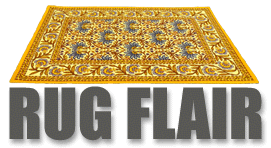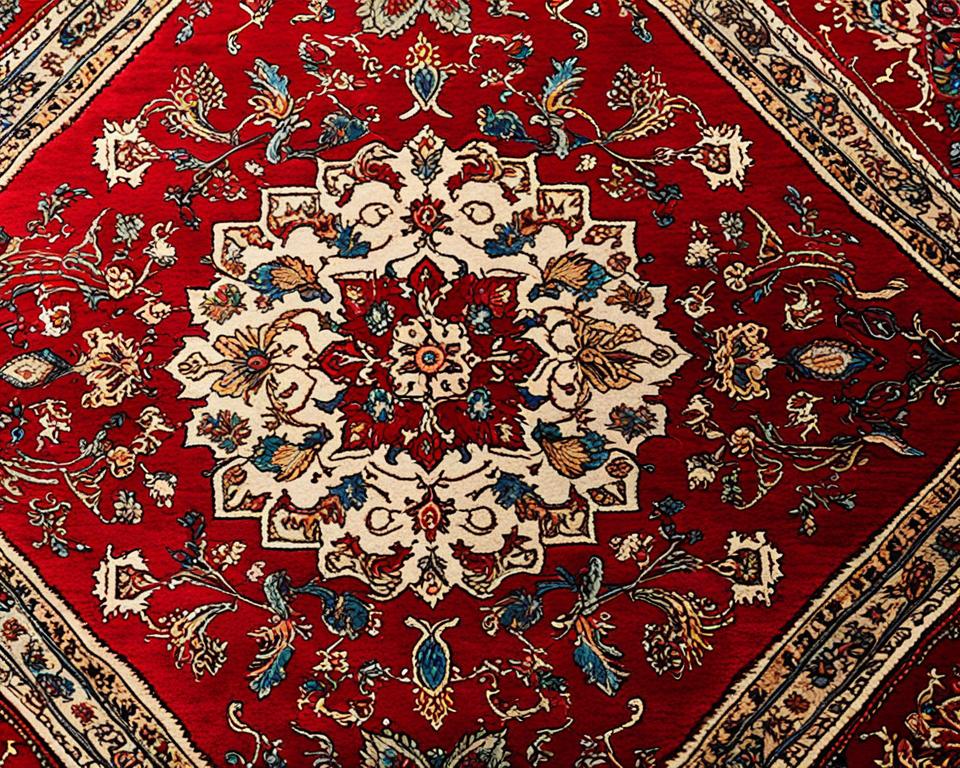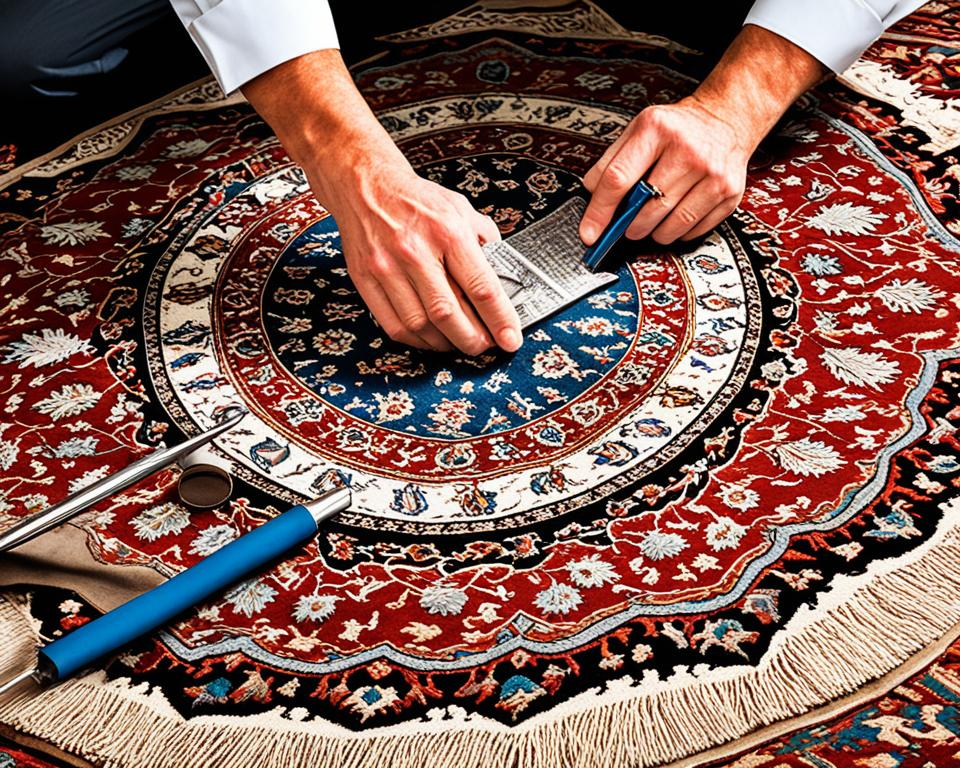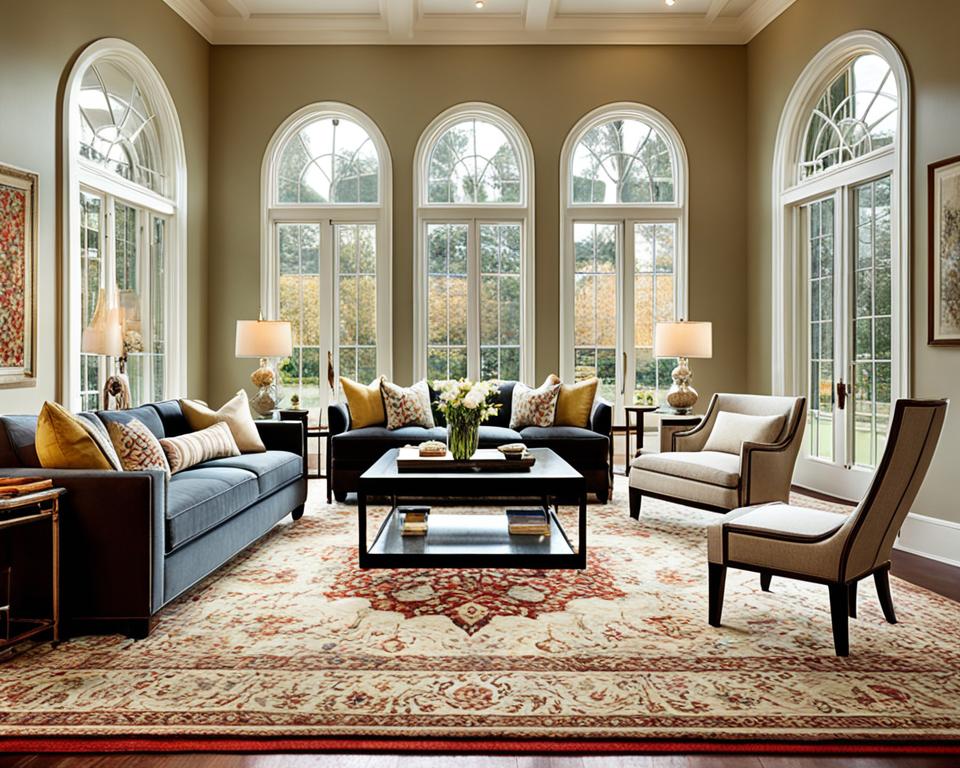Imagine stepping into a space where the rich history of traditional Asian floor coverings meets the sophistication of modern design. That’s the enchantment of the best Oriental rugs, which transform your home with their intricate patterns and opulent textures. From the plush indulgence of premium wool area rugs to the refined elegance of luxury Persian carpets, these exquisite floor treasures are more than mere decor—they symbolize a legacy of artisan craftsmanship. Whether gracing your floors with the vibrant symmetries of exquisite Turkish kilims or the delicate finesse of elegant handwoven rugs, each piece invites you to partake in a timeless tradition of beauty and luxury.
Key Takeaways
- Oriental rugs signify a deep heritage of artisan craftsmanship that enhances home interiors.
- Investing in a premium wool area rug offers both opulence and lasting durability.
- Luxury Persian carpets are not just rugs, but heirlooms that carry a story and history.
- Exquisite Turkish kilims provide bold patterns that cater to a modern yet traditional palate.
- Elegant handwoven rugs incorporate unparalleled skill, making each rug a one-of-a-kind artifact.
- Understanding the authenticity and origins of these rugs is pivotal to making an informed purchase.
The Rich History and Legacy of Oriental Rugs
Step back in time to the ancient civilizations where the best Oriental rugs were not only fundamental elements of daily living but symbols of prestige and artistry. These traditional Asian floor coverings have been cherished for millennia, each one telling a unique story through its meticulously handcrafted design.
The earliest known Oriental rug, the Pazyryk rug, dates back to the 5th century BCE and is a testament to the enduring craft of rug-making. These handmade artisan tapestries are products of heritage, with intricate patterns that reflect the cultural essence of regions ranging from the Middle East to the Far East. A true Oriental rug does more than just adorn a floor; it brings with it the whispers of history, the touch of long-ago hands, and the visions of ancient artisans.
Traditional techniques such as pile-weaving have ensured that Oriental rugs stand the test of time, both in durability and style. It is their ageless beauty that makes them iconic pieces in any household, with their allure only deepening as they transition from contemporary decorations to treasured heirlooms.
One could argue that these floor coverings are not merely rugs but a canvas of history—each knot, a brushstroke of the past, each color a shade of bygone eras.
Perhaps you’re an aficionado of these timeless pieces, or simply someone who appreciates the elegance they bring into a room. The legacy of an Oriental rug goes beyond its visual appeal, encompassing centuries of tradition and the remarkable skill of artisans who have weaved these stories under their nimble fingers.
- Artisanal Excellence: Passed down through generations, the craft involves intricate, age-old techniques that are the hallmark of high-quality rugs.
- Cultural Imprints: Each rug carries within its fibers the tales of its origin, bearing motifs and designs unique to its geographical heritage.
- Timeless Heirlooms: Beyond decoration, these rugs serve as enduring mementos of artistic expertise that continue to captivate and inspire.
In your quest for the perfect Oriental rug, letting history guide your choice is to embrace a legacy that has been shared across continents and time. A legacy that perhaps, one day, you will pass on, adding your chapter to its rich narrative.
Unfolding the Persian vs. Oriental Rugs Debate
Embark on a journey through the rich tapestry of luxury Persian carpets and the broader array of finest hand-knotted carpets known collectively as Oriental rugs. Here, we delve into the heart of what sets these traditional Asian floor coverings apart and explore the roots of this intricate debate.
Origins and Geographical Significance
Originating from a legacy that dates back to ancient Persia, luxury Persian carpets are revered worldwide for their distinct craftsmanship, exclusively made within the borders of modern-day Iran. In contrast, Oriental rugs weave together a larger narrative that encompasses the traditional weaving skills of various artisans from countries such as Afghanistan, Turkey, and India. As we unfold this narrative, we understand that the term “Oriental rug” serves as an umbrella encompassing an array of hand-knotted marvels, each representing the geographical essence of its origin.
Design Patterns and Cultural Symbolism
The intricate design patterns of Persian and Oriental rugs are not mere decorations but reservoirs of cultural symbolism. The patterns weaved into these rugs tell tales of the traditions, beliefs, and histories of the people who created them. While Persian rugs often boast signature motifs like the boteh or paisley, oriental rugs can exhibit a diverse range of patterns from geometric to figurative, each with its own cultural significance.
Traditional Asian floor coverings like these are more than home accessories; they’re storied pieces that carry the whispers of the past into contemporary settings, ensuring that the art of rug making is preserved and appreciated for generations to come.
- Each knot of a Persian carpet whispers of its age-old artistry.
- Oriental rugs from the broader region showcase the diversity and shared heritage of traditional weaving.
- In your hands lies a piece of history, where each pattern holds a story waiting to be told.
Whether you seek the lush sophistication of a luxury Persian carpet or the varied charm of the finest hand-knotted carpets, your home can become a gallery showcasing the enduring legacy of traditional Asian artisanship.
Who Are the Ideal Buyers of Oriental Rugs
Envisioning a space that exudes sophistication and cultural depth often involves integrating the exquisite artistry of luxury Persian carpets or traditional Asian floor coverings. These are not merely decorative elements; rather, they are profound expressions of heritage and craftsmanship. As such, the ideal buyer of these finest hand-knotted carpets tends to be someone with a discerning eye for quality and a reverence for the narratives woven into each piece.
If you resonate with the appreciation of rich cultural history and possess a penchant for distinguished decor, then an Oriental rug might be the next addition to your home’s elegance. Such a buyer not only values aesthetics but is also prepared to invest time in maintenance and care, ensuring that the rug retains its opulence for future generations.
Guided by an appreciation for the artistry and quality, the connoisseurs of luxury Persian carpets are the ones who can truly embrace the storied past and opulent presence of traditional Asian floor coverings.
Oriental rugs demand more than a financial investment; they ask for a lifestyle that accommodates their delicacy and design. Thus, those with a lifestyle that can meld with the affluent legacy of these rugs, alongside a taste for enduring style, are the ideal buyers. With prestigious patterns that resonate with bygone eras, these carpets fit perfectly into homes that reflect a classical taste or a thirst for authentic, global narratives.
The ownership of such traditional floor art becomes a commitment to preserve a slice of history, hence prospective buyers are often those who cherish heritage and are willing to embark on the journey of caring for these woven treasures.

- You seek not just an accessory but a piece of art that reflects your passion for culture and tradition.
- You understand and appreciate the workmanship that goes into creating the finest hand-knotted carpets and are willing to support the artistic communities that continue these time-honored practices.
- You are creating a home environment that values and showcases heritage pieces as central to your interior design philosophy.
Ultimately, the tapestries that adorn your floors are a statement about your values and vision for your living space. In acquiring an Oriental rug, you’re not just purchasing a product; you’re adopting a lineage of artisanal talent that exudes luxury, class, and timeless elegance.
Identifying Genuine Oriental Rugs: Real vs. Counterfeit
When it comes to furnishing your home with elegance, the allure of top-quality silk rugs and handmade artisan tapestries cannot be underestimated. However, the market’s saturation with counterfeit products means that authenticating authentic Oriental rugs is more important than ever. The unique character of genuinely hand-knotted rugs, crafted with painstaking attention to detail and quality materials, stands in stark contrast to their mass-produced imitators.
To ensure that you’re investing in a piece that not only enhances your interior but also carries lasting value, let’s delve into the critical distinctions between genuine and counterfeit Oriental rugs.
Firstly, it’s essential to remember that the price tag can be a significant indicator of an Oriental rug’s authenticity. Genuine rugs, renowned for their intricate designs and durable materials, rarely feature rock-bottom prices. While an astounding deal might be tempting, it often signals a compromise on quality—which genuine authentic Oriental rugs do not make.
Remember, a genuine Oriental rug is a piece of history—not just a piece of decor. It embodies the traditions and artistry of ancient craftspeople.
Here are some pragmatic steps you can take to identify a genuine Oriental rug:
- Examine the Materials: Authentic rugs are typically made of hand-spun wool or silk, presenting a distinct sheen and a smooth, soft feel underfoot. Any hint of synthetic fibres should raise suspicions.
- Craftsmanship: Look for irregularities in the weave—true signs of handcrafting—as machine-made rugs feature perfect, uniform knots and patterns.
- Design Authenticity: True handmade artisan tapestries often have slight color variations and unique design quirks that make each piece one-of-a-kind.
- Dealer Reputation: Purchase your rug from a trusted dealer, known for their collection of top-quality silk rugs and authentic Oriental rugs. These dealers have a vested interest in upholding their reputation by selling genuine articles.
Understanding these nuances means that when you buy an Oriental rug, what you’re really bringing into your home is a narrative—a story of culture, art, and impeccable craftsmanship. By owning a genuine piece, you preserve and pay tribute to a time-honored tradition.
Oriental Rugs Craftsmanship: Professional vs. Village Creations
As you delve into the world of best Oriental rugs, you will discover two distinct categories of craftsmanship: those cultivated in professional workshops and those birthed within village or tribal environments. Each origin brings with it a unique story, intricately woven into the very fabric of the rugs themselves.
Probing these categories further, one finds exquisite differences. Professional workshops are akin to high-caliber studios where premium wool area rugs are meticulously crafted. These venues are the birthplaces of many exquisite Turkish kilims, sought-after for their precision, influenced heavily by the ebbs and flows of market trends. With each thread woven under the watchful eye of a master weaver, these rugs often boast uniformity and quality upheld to the uppermost standards.
In contrast, the village and tribal rugs offer a canvas brimming with creative freedom, reflecting the personal narratives and untethered spirits of the communities that create them. In these environments, the rigorous precision of professional settings gives way to an authentic, often rustic charm. Yet, it is paramount to understand that this liberty may result in varying levels of quality, where the threads sing songs of individuality rather than unison.
Whether your heart sets on the flawless artistry of a professional creation or the authentic vitality of a tribal piece, the choice shapes the stories you choose to weave into the tapestry of your home.
Understanding where your rug comes from—whether it is a village kilim humming with the tales of its weaver or a professional masterpiece defining luxury in every knot—is essential. This knowledge not only informs your decision but also enhances your appreciation for the rug’s deep-rooted craftsmanship.
- Professional Workshop Rugs: Symbolize the meeting point of tradition and market demand, dictating a design ethos approached with precision and uniformity.
- Village and Tribal Rugs: Embodied with idiosyncrasies, these rugs tell unrestricted stories, often reflecting eclectic tastes and the essence of a culture rooted in every weave.
No matter the origin, whether it’s the exquisite Turkish kilims captivating with their geometric bravado, the premium wool area rugs embracing your feet in luxury, or the rugged allure of an anonymous artisan’s work, each rug encompasses a narrative waiting to be unveiled and cherished in your living space.
Essential Tips for Determining the Authenticity of an Oriental Rug
Discerning the authenticity of an Oriental rug can feel like a journey through a labyrinth of threads and patterns, but fret not! By focusing on key authenticity indicators such as knot density, materials used, and craftsmanship, you can navigate this maze with confidence. Aim to acquire nothing less than top-quality silk rugs, finest hand-knotted carpets, and authentic Oriental rugs. Let’s unravel these threads of truth together.
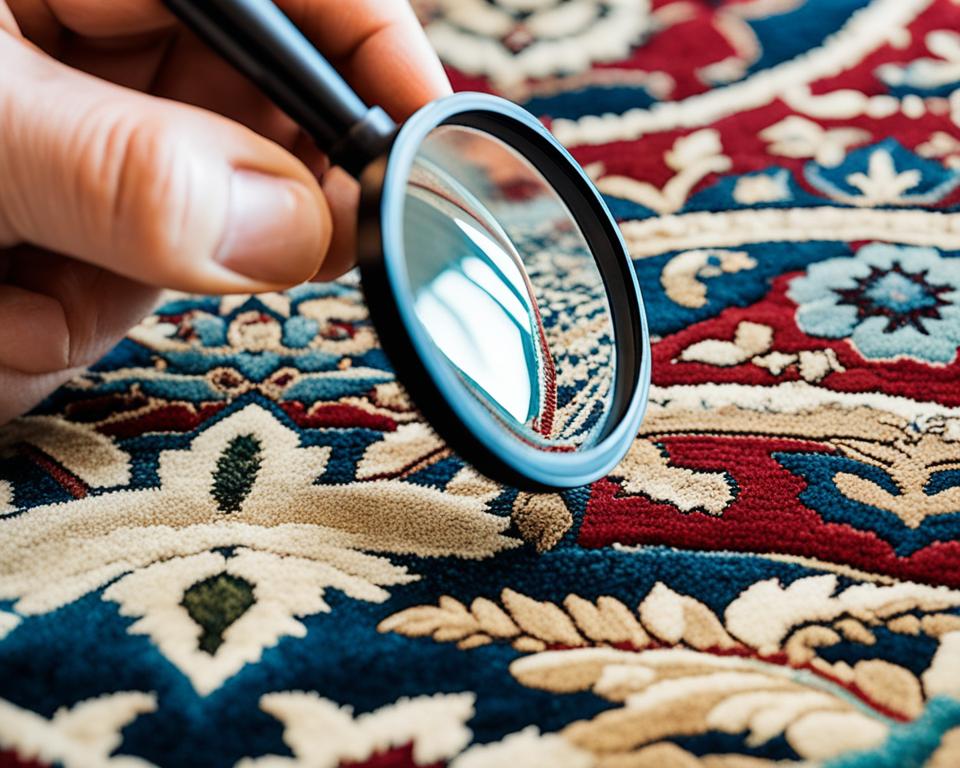
Knot Density: A traditional hallmark of the finest hand-knotted carpets is their knot density, a direct measure of the rug’s intricacy and durability. Typically, the higher the knot count, the finer the weave—making it one of the most revealing signs of a rug’s quality.
Materials Matter: Authentic Oriental rugs are renowned for their luxurious natural fibers, such as silk and hand-spun wool. These materials not only contribute to the rug’s luster and softness but also its overall longevity.
Fringe Benefits: The fringe of a rug often discloses clues to its authenticity. An original fringe is an extension of the rug’s warp threads, whereas a sewn-on fringe might signal a counterfeit.
When in the presence of authentic Oriental rugs, you’re not just standing on a floor covering, you’re standing on a piece of history imbued with centuries of tradition and skilled artisanship.
As part of your due diligence, always prioritize purchasing from reputable dealers with a storied history of dealing in top-quality silk rugs. Inquire about the rug’s provenance, the conditions under which it was crafted, and potentially seek a third-party expert’s scrutinizing eye to ensure you’re investing in a genuine article. A dealer well-versed in the authenticity of Oriental rugs should gladly share detailed information about the rug and may even provide a certificate of authenticity.
Below is a checklist to guide you through the essential aspects of an Oriental rug that you should evaluate:
| Authenticity Indicator | Details to Consider |
|---|---|
| Knot Density | A high number of knots per square inch indicates finer craftsmanship. |
| Materials Used | Look for natural fibers like silk or hand-spun wool for true quality. |
| Fringe Examination | Authentic rugs have fringes that are integral parts of the rug’s structure. |
| Dealer Reputation | Choose dealers known for their expertise and a respectable collection of rugs. |
| Visual Inspection | Assess irregularities in design and color, which can indicate handcrafted authenticity. |
| Expert Evaluation | An expert can provide assurance of authenticity and value before purchase. |
Taking these precautionary steps ensures that the rug under your feet is not just a decor piece but a genuine representation of cultural narrative and prized craftsmanship—something that truly stands the test of time.
Quality Hallmarks of the Finest Hand-Knotted Carpets
When delving into the world of finest hand-knotted carpets, understanding the attributes that differentiate a masterpiece from a mere floor covering is key. Recognizing these quality hallmarks not only ensures that you get value for your investment but also brings a piece of textile art into your home that can stand the test of time and fashion. Today, let’s explore the two cornerstones of excellence in hand-knotted rugs: knot density and the materials and techniques used in weaving.
The Importance of Knot Density
The term ‘knot density’ refers to the number of knots per square inch (KPSI) in a rug, and it’s a primary measure when assessing the finest hand-knotted carpets. This factor is a direct reflection of the rug’s resilience, texture, and clarity of its intricate designs. The more knots per square inch, the more detailed and durable the carpet is likely to be. It indicates the time and skill invested into each woven square inch, adding to the carpet’s overall value and sophistication.
Materials and Weaving Techniques
Discerning the quality of your best Oriental rugs and top-quality silk rugs comes down to not just design, but the very fabric of the rug itself. Luxury materials such as high-grade silk and premium wool distinguish a genuine work of art from imitations. There’s a certain sheen and softness with silk, while high-quality wool contributes to a durability and warmth that artificial fibers cannot replicate.
The variety of weaving techniques stand testament to the artisan’s prowess. Different regions impart their own signature on the weave—from the intricate curvilinear patterns of Persian workshops to the bold, geometric strength of Anatolian tribes. This diversity not only charms collectors but is indicative of a rug’s origin and authenticity.
| Indicator of Authenticity | Knot Density (KPSI) | Materials Used | Signature Weaving Technique |
|---|---|---|---|
| Persian Rugs | 200 to over 500 | Silk, High-Quality Wool | Curvilinear, floral motifs, dense weave |
| Turkish Rugs | 80 to around 200 | Wool, occasional silk highlights | Geometric designs, Ghiordes knot |
| Indian Rugs | 100 to 300 | Silk, Wool | Mughal inspired motifs, detailed figures |
| Caucasian Rugs | 80 to 200 | Wool, with high lanolin content | Bold, geometric patterns, Kazak designs |
| Chinese Rugs | 70 to 300 | Silk, Wool | Symbolic motifs, Peking pattern |
Whether you’re a seasoned collector or venturing for your first purchase, knowledge of these quality hallmarks arms you with the necessary insight to select the best Oriental rugs. It’s not just an adornment for your home but an enduring legacy—a narrative of fine craftsmanship passed through the hands of time.
How to Conduct a Field Test on an Oriental Rug
If you’re captivated by the charm of handmade artisan tapestries and the rich legacy of traditional Asian floor coverings, knowing how to authenticate an authentic Oriental rug is crucial. Conducting a field test is a proactive step to ensure you’re investing in a genuine artifact, especially when dealing with online purchases or sellers with less prominence. Here are some hands-on techniques to help you differentiate a true Oriental masterpiece from its counterfeits.
Begin by flipping the rug to inspect its underside. This is where the true tale of the tapestry comes to light. The back of authentic rugs often reveals the intricacies of the weave—the irregularities that speak of human touch and tradition. A pattern that aligns exactly on both sides is often a mark of machine-made replicas, not the authentic Oriental rugs they imitate.
- Examine the Knot Density: High-density knots, often counted in the hundreds per square inch, indicate a labor-intensive handcrafting process. This density contributes to the durability and the detailed artistry of the rug.
- Assess the Fringe: Authentic rugs have fringes that are extensions of the rug’s foundation, which may appear less uniform than those on machine-made rugs. Check the fringe to see if it’s integrated into the weave or if it’s glued or sewn on—an immediate red flag.
- Feel the Materials: Silken sheen and woolen warmth are indicators of a genuine rug. If the texture feels off or if the fibers seem brittle or excessively uniform, they may not be the natural, high-quality fibers that authentic Oriental rugs are known for.
The following Field Test Checklist will help guide you through a detailed examination:
| Action | What to Look For | Authenticity Sign |
|---|---|---|
| Visual Inspection | Pattern continuity and weave uniformity | Imperfect alignment and varying knot sizes |
| Fringe Examination | Fringe origin – attached or affixed | Integral to the rug’s structure |
| Knot Density Check | Number of knots per square inch | High knot density, preferably over 200 |
| Texture Feel | Material quality – silk or wool | Soft, supple, natural fibers |
Remember, these field tests may slightly distress the rug, so always seek permission from the seller before conducting them—or better yet, make your purchase with the condition of an expert inspection.
It’s also helpful to ask for detailed rug history, origin, and possibly proof of authenticity. A seller confident in their inventory will provide transparency about their handmade artisan tapestries and will understand their importance to savvy collectors like you. Trust in these field tests, and soon, you’ll have the perfect traditional Asian floor covering to enrich your home with beauty and history.
Where to Purchase the Best Oriental Rugs
Embarking on the quest for the ultimate luxury Persian carpets or the most authentic traditional Asian floor coverings leads discerning decorators and collectors to a pivotal decision: where to purchase these exquisite items. The journey to finding the best Oriental rugs converges at the need for reputable dealers with an unblemished history of quality and authenticity.
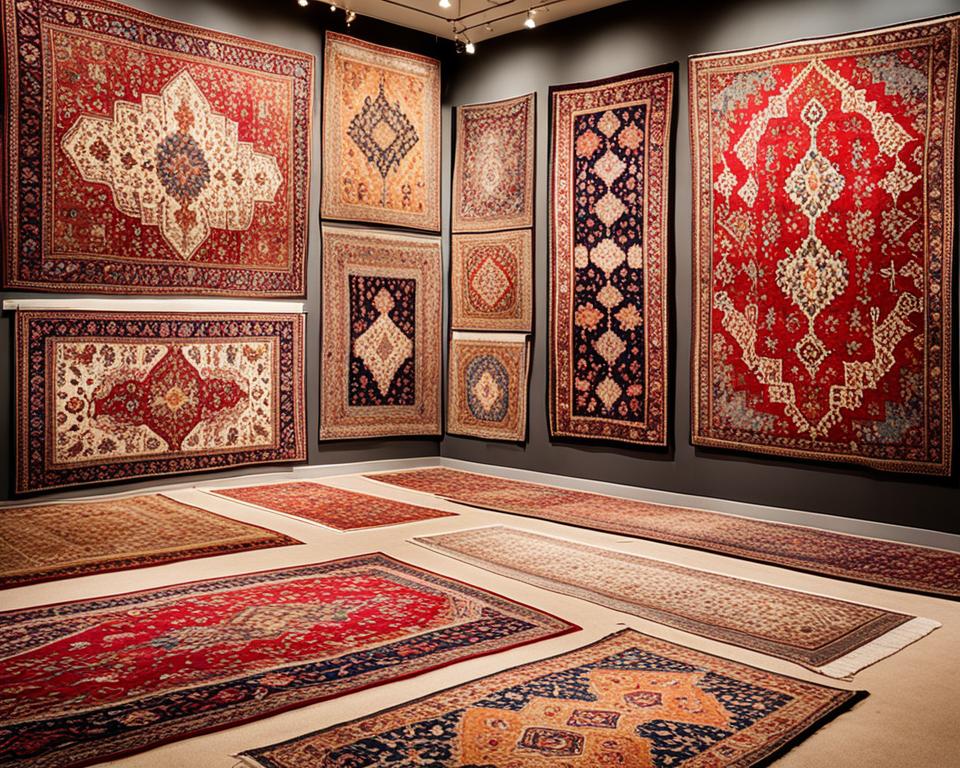
Choosing Reputable Dealers and Avoiding Common Pitfalls
When hunting for that perfect piece to complete your space, it’s imperative to contemplate the reputation and expertise of the seller. The finest luxury Persian carpets deserve outlets where their storied lineage is honored and upheld. Esteemed merchants, lauded for their intricate selection of traditional Asian floor coverings, typically boast a portfolio of successful transactions, glowing customer reviews, and an abundance of knowledge about the provenance of their wares.
Avoid the allure of high-pressure sales tactics or promotions that seem implausibly attractive. Such strategies might lead to acquisitions of lesser caliber. Instead, turn your attention to dealers who prize transparency, eagerly share their wisdom, and offer a solid return policy, should your selection not meet your expectations.
Understanding the Importance of Origin in Rug Quality
The place of origin is not just a detail in the rich tapestry of an Oriental rug—it is a defining characteristic of its quality and authenticity. With the intention of owning a genuine piece, verifying this detail is as vital as the carpet’s intricate patterns and plush pile. An authentic best Oriental rug will carry the signature of its heritage, a testament to the time-honored techniques and natural materials from which it was created.
As you navigate the expansive world of such floorscapes, bear in mind that the truest Oriental rugs do not bear the imprints of mass production but rather the distinctive handcrafted knots and dyes of their native land. This connection to place and tradition is what elevates a beautiful rug to the pinnacle of art for your floors.
Whether you are adorning a personal space or searching for an iconic piece for a business environment, the confluence of these elements—reputation, wisdom, transparency, and knowledge of origin—governs where the smart investment lies. It is within the sanctuaries of trusted vendors that the best Oriental rugs find their way to those who appreciate their splendor.
The Art of Maintaining and Caring for Luxury Persian Carpets
When it comes to luxury Persian carpets, their opulence is matched only by the intricacy required in their care and maintenance. To ensure the longevity and vibrant beauty of these exquisite textiles, one must adhere to a regimen that respects the delicate nature of these artifacts. The aesthetic and structural integrity of your prized exquisite Turkish kilims and Persian rugs depends greatly on the care they receive.
Understanding the fibers and dyes that compose your carpet, along with the appropriate cleaning methods, is crucial. Here are essential care guidelines that help keep your Persian carpets and Turkish kilims looking as majestic as the day they were woven:
- Regular Vacuuming: Gentle vacuuming on a regular basis can remove dirt and dust that may wear down the pile over time.
- Immediate Spill Response: In the event of spills, prompt blotting with a clean cloth can prevent stains from setting into the fibers.
- Professional Cleaning: Every two to five years, depending on foot traffic, a professional rug cleaner should deep clean your luxury carpet to maintain its luster.
- Avoid Harsh Chemicals: Harsh cleaning agents can damage natural fibers and fade the dyes; always opt for mild detergents.
- Rotation: Rotating your rug 180 degrees every few months ensures even wear and helps maintain its uniform appearance.
- Placement Away from Sunlight: Direct sunlight can cause fading. Position your carpets in areas where sun exposure is limited or use window treatments to protect the colors.
For instances where you’re unsure about the correct procedure, it’s best to consult with a professional who specializes in the care of luxury Persian carpets. Below is a table that outlines specific cleaning techniques for different types of incidents that your rug might encounter:
| Type of Incident | Recommended Action | Professional Assistance Needed? |
|---|---|---|
| Dust and Everyday Dirt | Regular vacuuming with a brushless suction to prevent pulling on the knots. | No, unless the rug is extremely delicate or antique. |
| Spills and Stains | Blot immediately, then clean with a damp cloth and mild carpet shampoo. | Yes, for persistent stains or if the rug cannot be dried quickly. |
| Pet Accidents | Clean with a mixture of water and white vinegar, blot dry. | Yes, due to potential damage from acids or persistent odor. |
| Wear and Tear | Routine rotation, use of padding underneath the rug to prevent slipping and wear. | Yes, for repair and restoration advice. |
| Color Fading | Keep out of direct sunlight, use UV protective window film if sunlight exposure is unavoidable. | Yes, for professional color restoration services. |
By embracing these guidelines, you become a guardian of the art, history, and craft of your luxury Persian carpets and exquisite Turkish kilims. Proper care and maintenance is not just about upkeep—it’s about honoring and preserving the tradition and handiwork of the skilled artisans who crafted these luxurious woven masterpieces.
Best Oriental Rugs: A Blend of Traditional and Contemporary Decor
When searching for the perfect home decor, the best Oriental rugs stand out for their versatility and ability to bridge the gap between antiquity and modernity. These elegant handwoven rugs are more than mere floor coverings; they are a testament to centuries-old traditions that resonate within contemporary spaces. The beauty of an Oriental rug lies in its capacity to become the centerpiece of any room, embodying a delicate balance of color, pattern, and texture that complements your living environment.
As you consider integrating these traditional Asian floor coverings into your decor, weigh the design elements they bring. Do the intricate patterns of the rug align with the modern minimalist furniture in your space? Will the vibrant shades within the weave warm up a room’s neutral palette? This thoughtfulness ensures that your chosen piece not only enhances the aesthetic of your environment but harmoniously melds with it, creating a dialogue between old and new.
The right Oriental rug can also defy the confines of style, showing that something so steeped in history can still be forward-facing. When placed in a contemporary setting, these rugs offer a surprising edge—breaking the monotony with a splash of heritage, while in a traditional setting, they reinforce the room’s historical narrative.
Spending time to understand the origins and construction of these rugs can greatly influence your selection process. Artisans imbue each rug with a narrative, seen in the unique dye techniques and weaving patterns specific to their cultural region. By familiarizing yourself with these distinctions, you choose a rug that’s not just perfect for your room but also for your storytelling.
Below is a guide to help you fuse traditional artistry with modern design:
| Decor Style | Oriental Rug Type | Effect on Decor |
|---|---|---|
| Minimalist | Neutral-toned Kilim | Adds texture without overwhelming the space |
| Eclectic | Bold Persian | Makes a statement and accentuates diverse elements |
| Contemporary | Geometric Tribal Rug | Provides an artistic touch and complements modern aesthetics |
| Bohemian | Colorful Ikat | Amplifies the free-spirited nature of the space |
| Traditional | Classic Oriental | Reinforces the rich, historical look of the room |
Takeaway: The ability of Oriental rugs to beautifully intertwine with both traditional and contemporary interiors makes them a timeless addition to any home. When selecting such a piece, evaluate how it will engage with your existing decor, and consider the narratives woven into its fabric. An Oriental rug is not just a purchase; it’s a choice to enliven your home with a story of distant lands and ancient practices that continues to enthral today.
Conclusion
The collection of information presented in this article underscores the deep cultural footprint and the exceptional artistry behind the best Oriental rugs. Their timeless appeal is rooted in a profound lineage of skilled craftsmanship, elevating any living space they grace. As you venture into the enchanting world of luxury Persian carpets, premium wool area rugs, and exquisite Turkish kilims, the wisdom you have gained here serves as a beacon to guide your choices.
Your understanding of the history, the meticulous process of hand-weaving, and the significant care needed shouldn’t merely inform your purchase—it should also infuse a sense of connection to a time-honored craft. Embracing one of these rugs is akin to welcoming a piece of world heritage into your home, with each pattern, color, and knot narrating age-old stories of culture and tradition.
Remember, an educated acquisition not only enriches your aesthetic environment but also honors the artisans’ dexterity, echoing their legacy through your interior decor. May your choice of rug from the vast tapestry of options available carry with it the intrinsic value and profound elegance that only the best Oriental rugs can offer, imbuing your home with a beauty that transcends time and trend.
FAQ
What distinguishes the best Oriental rugs from ordinary floor coverings?
The best Oriental rugs are characterized by their exceptional craftsmanship, premium materials such as high-quality wool and silk, and intricate designs that are hand-knotted with precision. Unlike ordinary floor coverings, these traditional Asian floor coverings often become treasured heirlooms, valued for their aesthetic and historical significance.
Are all Persian carpets considered Oriental rugs?
Yes, all Persian carpets are a subset of Oriental rugs. Luxury Persian carpets are specifically made in Iran and are known for their rich patterns and superior quality. Oriental rugs include a broader category of finest hand-knotted carpets from regions across the Middle East and Asia.
How can I tell if an Oriental rug is authentic or counterfeit?
To distinguish between an authentic Oriental rug and a counterfeit, look for signs of hand-knotting, check the knot density, inspect the materials for quality (such as natural fibers like silk and wool), and examine the rug’s original fringe. Authentic pieces are rarely sold at extremely low prices or through mainstream retail outlets.
What are the differences between professional workshop Oriental rugs and village or tribal creations?
Professional workshop Oriental rugs usually feature designs catering to market demands, and their production is often overseen by master weavers, ensuring consistency in quality. Village or tribal rugs reflect the personal artistic expression of the weavers, and as a result, they offer unique patterns but may vary more in quality.
How important is knot density in evaluating the quality of hand-knotted carpets?
Knot density is a crucial indicator of an Oriental rug’s quality. Higher knot density generally means greater durability and detail in the rug’s design. It’s a key aspect to consider when seeking the finest hand-knotted carpets, as it affects both the rug’s aesthetic appeal and its longevity.
What should I look for when choosing a dealer to purchase an Oriental rug from?
Choose a dealer with a reputable history, positive customer feedback, and demonstrated expertise in Oriental rugs. Reputable dealers will be knowledgeable about the rugs’ origins, provide transparency about the rug’s history, and offer comprehensive customer service, including a reasonable return policy.
How should I care for luxury Persian carpets to ensure they last for generations?
Regular gentle vacuuming, immediate attention to spills, and periodic professional cleaning are essential to maintaining your luxury Persian carpets. It’s also important to protect them from prolonged exposure to sunlight and to rotate them to ensure even wear.
Can Oriental rugs be incorporated into modern decor styles?
Absolutely! Oriental rugs can serve as a unifying element that brings warmth and character to contemporary spaces. With their timeless elegance and varied patterns, these rugs can complement and enhance both traditional and modern interiors.
What is the significance of an Oriental rug’s design and how does it reflect cultural heritage?
The designs of Oriental rugs are deeply rooted in the cultural heritage of their respective regions. Patterns often tell stories or reflect symbols important to the artisans’ communities. Understanding the cultural and symbolic meanings behind the designs can enrich the appreciation of these exquisite handwoven rugs.
Is it possible to conduct a field test on an Oriental rug without damaging it?
Yes, with caution and the owner’s permission, one can conduct certain non-invasive tests. For example, by comparing the pattern on the front to the back of the rug, feeling for the texture and quality of the material, one can get indications of authenticity. Always handle the rug gently to avoid damage.
